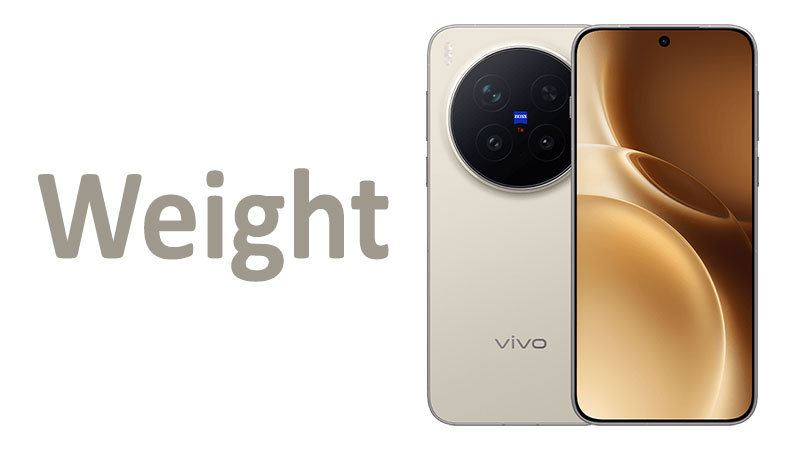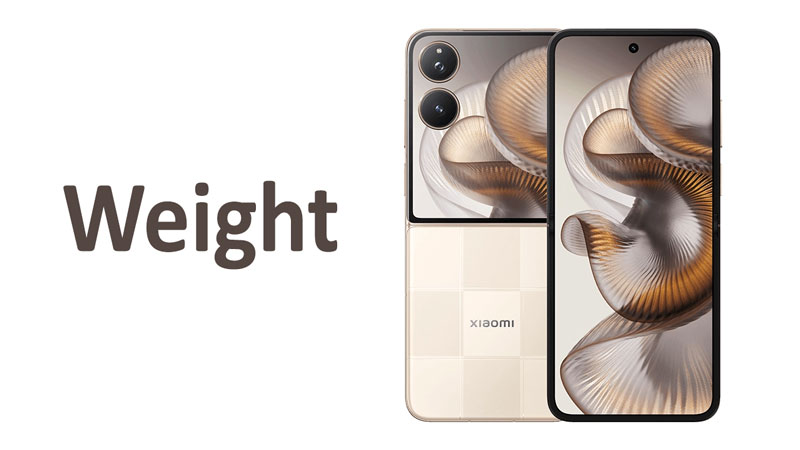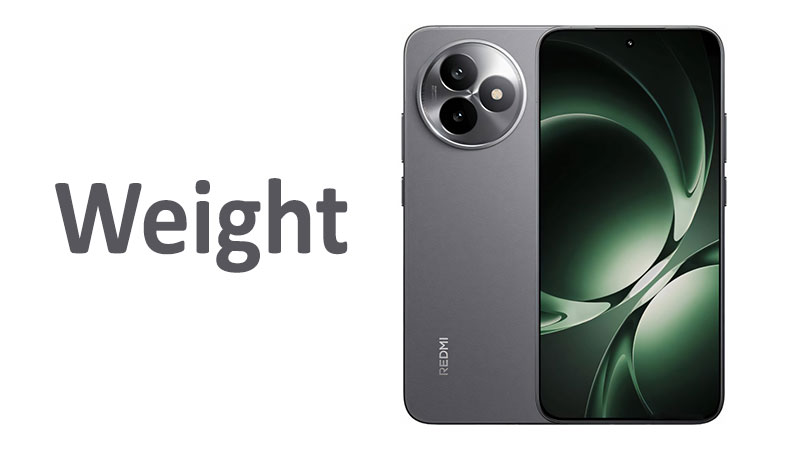The vivo X300 Pro Weight is a defining characteristic of this ultra-premium device. The phone registers a significant 226 g on the scale. This translates to 7.97 oz in imperial measurement units. This substantial mass places the X300 Pro firmly in the heavy-flagship category. Weight is a critical measure of a phone’s hardware capacity and build quality. A higher weight often correlates directly with advanced internal technology. It also suggests the use of denser, more robust materials. We will examine the implications of this 226 g figure thoroughly. This detailed analysis will cover ergonomics, comparisons to rivals, and engineering trade-offs.
The 226 g Benchmark: Details and Significance
The 226 g mass of the X300 Pro immediately signals its high-end nature. This numerical representation is far above the average smartphone weight. It shows that vivo did not compromise on premium internal components. The phone feels exceptionally solid and dense in the hand. This weight class confirms the use of a sturdy metal frame construction.
226 g also suggests the presence of a significantly large battery. Large battery capacity is crucial for a Pro-level device. It must power a large screen and demanding processors easily. Furthermore, the phone likely incorporates extensive camera hardware. This includes a heavy periscope telephoto lens system. These components contribute directly to the overall mass.
This weight offers a strong tactile sense of luxury. Users associate substantial weight with superior build quality. The phone avoids any feeling of being cheap or plastic. The mass is evenly distributed across the phone’s large chassis. This careful balance is necessary to prevent the phone from feeling top-heavy. The 226 g weight is a calculated engineering decision.
Ergonomics and Hand Feel at 226 g![]()
Weight has a profound impact on the phone’s daily ergonomics. The 226 g mass requires a firm and deliberate grip. This is especially true given the X300 Pro’s large screen size. The weight naturally leans the phone towards two-handed operation. Holding the phone for long periods will certainly cause hand fatigue.
Users accustomed to lighter phones will notice this mass immediately. Extended video calls or lengthy gaming sessions become more demanding. The substantial 7.97 oz requires periodic resting of the hand. This is the inherent trade-off for carrying top-tier components. The phone is not designed for featherweight comfort. It prioritizes power and features instead.
The weight also affects how the phone is carried. 226 g is noticeable in a jacket or pants pocket. It requires sturdy pocket material for comfortable transport. The mass reduces the risk of accidentally misplacing the phone. Its weight offers constant reassurance of its presence. However, users should be prepared for its noticeable presence. The X300 Pro is designed for heavy-duty use.
Specialized Comparison: X300 Pro vs. Base X300 Weight
The weight contrast between the Pro and base models is extremely sharp. The vivo X300 Pro weighs 226 g in total. The standard vivo X300 weighs a much lighter 190 g. This creates a significant difference of 36 g between the two phones. This 36 g gap is immediately discernible when holding both devices.
This large weight disparity highlights the Pro model’s hardware upgrades. The X300 Pro features a larger screen and a more advanced camera module. It almost certainly includes a larger battery capacity as well. This extra mass provides the superior feature set of the Pro device. Buyers should choose the Pro only if they require these heavier components.
The 226 g weight serves a clear purpose in vivo’s product strategy. The X300 Pro is designed for maximum performance and features. The base X300 targets users who prioritize portability and lightness. The 36 g difference helps buyers easily differentiate the two models. It represents a substantial commitment to power.
Specialized Comparison: X300 Pro vs. Key Competitors
Comparing the 226 g X300 Pro to rivals places it among the heaviest contenders. Most standard flagships typically weigh between 185 g and 200 g. The X300 Pro is significantly heavier than this standard range. It competes directly with the “Ultra” or “Max” variants from other brands. These variants often approach 230 g or more.
The X300 Pro is heavier than many large screen competitors. This added mass suggests component superiority in specific areas. It is competitive with phones utilizing stainless steel frames or ceramic backs. These materials inherently increase the total mass. The X300 Pro’s weight indicates its commitment to top-tier hardware.
Even folding phones, when closed, sometimes weigh less than the X300 Pro. This confirms the X300 Pro’s status as a weight outlier in the non-folding flagship market. Consumers looking for the lightest device must look elsewhere. The 226 g weight ensures the X300 Pro is only for users who demand extreme performance. This phone makes no compromises for lightness.
Pros and Cons of the 226 g Weight Class
The advantages of the 226 g weight are directly linked to internal capabilities. The primary pro is the massive battery capacity this weight allows. This ensures exceptional endurance for power users. Secondly, the weight confirms robust structural integrity and premium materials. It gives the phone a highly durable, high-quality feel. Thirdly, the weight is necessary for the advanced camera and cooling systems.
The stability in hand is a related benefit for photography. The substantial mass reduces minor jitters during video recording. It helps stabilize the frame for better low-light photography. The weight serves a functional purpose beyond just aesthetics. It is an indicator of maximum hardware inclusion.
The disadvantages are equally clear and important for buyers. The main con is the potential for significant hand fatigue during extended use. It is less comfortable to hold for long periods than lighter phones. Another con is the reduced portability. The phone feels heavy in pockets and can strain clothing. The total mass is exacerbated when a heavy case is added to the device.
Weight and Internal Components: The Hardware Justification
The 226 g weight is entirely justified by the complex internal hardware. The single largest contributor is the battery unit. To achieve all-day performance in a Pro phone, the battery must be large. It is likely near or above 5000 mAh capacity. This power cell alone adds significant mass.
The camera system is the second major source of the weight increase. The X300 Pro features a sophisticated, multi-lens setup. It includes a heavy glass element periscope telephoto lens. This optical hardware is dense and requires precise mounting. The stabilization systems for these cameras also utilize small motors. All these parts add to the final 226 g figure.
Furthermore, a powerful processor requires an advanced thermal management system. The phone likely uses a large vapor chamber and multiple graphite sheets. These metal components are necessary for dissipating heat efficiently. This hardware is critical for sustained peak performance. The 226 g weight is a direct reflection of its technical superiority.
Weight and Build Materials: Premium Construction
The materials selected for the X300 Pro contribute heavily to its mass. Vivo likely utilizes a surgical-grade stainless steel frame or a robust aluminum alloy. The stainless steel, if used, is much denser than aluminum. This material choice provides superior durability and rigidity. It prevents the phone from bending or twisting under stress.
Both the front and back panels use strong, protective glass. This glass is dense and heavy, further increasing the total mass. Some Pro models also feature a ceramic back option. Ceramic is heavier than standard glass or aluminum. This adds several grams to the final 226 g weight. The phone’s weight confirms the use of these luxury construction materials.
The goal is to create a device that feels indestructible and high-end. Plastic components are lighter but compromise on that premium tactile sensation. The weight of the X300 Pro is a deliberate design choice. It sacrifices lightness for maximum robustness and luxury feel. Every component choice supports this density.
Weight Density: A Key Metric for Premium Feel
Weight density is calculated by dividing the phone’s total mass by its volume. The X300 Pro has a large physical volume due to its 6.78 inch screen. Despite this larger size, the phone remains incredibly dense at 226 g. This high density is what makes the phone feel solid. It eliminates any perception of being hollow or fragile.
High-density construction is a hallmark of truly premium flagships. A larger phone with poor density feels inexpensive or poorly balanced. The X300 Pro’s weight ensures a satisfying heft in the hand. This weight confirms that the internal space is efficiently packed with high-quality components. The phone feels precisely engineered and meticulously assembled.
The weight density contributes to the phone’s perceived value. Users often equate density with internal complexity and robust engineering. The 226 g mass, spread across the large body, achieves this perfect sense of concentrated quality. It is a critical psychological factor for buyers seeking the absolute best.
Weight Distribution: Balance Under Load
The distribution of the 226 g mass is crucial for real-world usability. A poorly balanced heavy phone is difficult to manage. Vivo engineers must ensure the center of gravity is precisely controlled. It is likely centered or slightly lower to prevent top-heavy tilting. A low center of gravity improves grip security and minimizes hand strain.
Good weight balance is critical for the camera experience. Users often hold the phone by its lower half while capturing photos. If the weight is poorly distributed, the phone might feel wobbly. The balanced mass of the X300 Pro ensures stability for the advanced camera system. This results in sharper images and smoother video footage.
Even weight distribution helps when the phone is placed on a wireless charger. The phone sits flush and securely due to its mass. This stability is essential for high-speed charging. The 226 g mass is a well-managed characteristic. It works in conjunction with the phone’s large dimensions.
Important Buyer Knowledge for 226 g![]()
Buyers considering the X300 Pro must prepare for its considerable weight. This phone is not suitable for users who prioritize featherlight carrying comfort. The 226 g is a daily commitment to carrying power. Buyers should physically test a phone of similar weight before purchasing. This prevents later disappointment regarding handling.
Adding a heavy-duty, protective case is a common practice. This addition will increase the total weight considerably. A heavy case could push the total mass to 260 g or more. This weight is comparable to small tablets. It is essential to factor this increase into your daily carry expectations. Choose a lightweight case to minimize the impact on the phone’s weight.
The weight is a positive indicator of key features. It strongly suggests superior battery life and exceptional camera performance. If these two features are your highest priorities, the 226 g is a justifiable trade-off. This phone is built for professional users and multimedia enthusiasts. They require the internal hardware that necessitates this mass.
Conclusion: An Informed Decision on the X300 Pro Weight
The vivo X300 Pro Weight of 226 g (7.97 oz) defines its identity. It is a heavy, powerful, and uncompromised flagship device. This substantial mass is the direct result of superior engineering choices. It accommodates a massive battery, premium build materials, and an advanced camera suite. The weight confirms the phone’s premium, robust construction.
The 226 g mass places it among the heaviest tier of modern smartphones. It is significantly heavier than the base X300 model. This makes the X300 Pro the superior choice for power users. They require maximum endurance and feature set. They accept the higher weight as a necessary consequence of extreme performance.
The decision is straightforward for potential buyers. If you require a lightweight, comfortable daily driver, choose the X300. If you demand the largest battery, best camera, and highest build density, choose the X300 Pro. Its 226 g weight is the price of unbridled flagship power and luxury. This phone is a statement of uncompromising performance.
Frequently Asked Questions (FAQ)
1. What is the total mass of the vivo X300 Pro?
The vivo X300 Pro weighs a heavy 226 g, which is equivalent to 7.97 oz.
2. Why is the X300 Pro heavier than the base X300?
It is heavier because it includes a larger battery, a bigger screen, and a more advanced camera system.
3. Does the X300 Pro’s weight mean it has a big battery?
Yes, the 226 g weight is a very strong indicator of a high-capacity battery unit for extended usage.
4. How does the X300 Pro compare to other flagship weights?
The 226 g weight is heavier than most standard flagships. It competes with “Ultra” or “Max” models.
5. Will the 226 g cause hand fatigue during use?
Yes, the substantial weight may cause hand fatigue during long gaming or viewing sessions. It is best used two-handed.



